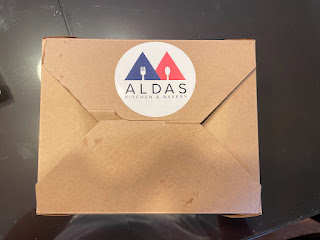It's Filipino-American History Month in the USA. This piece is my small way of contributing to this celebration.
---
While working in rice quality research, I encountered several discussions on why Filipino cuisine has not been "elevated" to fine dining and why it is not as popular as Chinese or Thai cuisine in the USA. I did not follow the discussions, unfortunately.
However, I have been discovering Filipino restaurants in the Bay Area. Many of them, like Lutong Bahay and Island Pacific's PhilHouse, are of the turo-turo style (think cafeteria). Others, however, have ventured away from this restaurant style and sought to feature Filipino food in their own way.
The fare has, so far, been satisfying.
My go-to pick-up counter for brunch. I found the owner's business model to be very smart because he/she can concentrate on preparing delicious food instead of dividing his/her attention between food preparation and service. The food comes beautifully wrapped in a paper box, the Western version of the binalot back home (one's meal wrapped in banana leaves).
I've ordered food from Aldas twice. I particularly like the salmon fried rice (it goes well with the nori). Mommy was impressed by the relatively big portion size.
Despite receiving a Michelin Bib Gourmand distinction, this restaurant remains rooted in the chef's food heritage. Although pancit, lumpia, and adobo are served there, FOB Kitchen also has kare-kare, bistek, and lechon kawali that remind me so much of home... and of the research I worked on with Matty and his team of scientists trying to understand consumer food choice (gastronomic systems research). The dishes on the menu were meat-centric fare (typical of Filipino cuisine); however, FOB Kitchen also serves vegetable-centric dishes containing textures, flavours, and aromas that balance the meat flavours.
I became an instant fan on my first dinner here (with Val and Donan). I liked the pancit and the adobo. But I was impressed by the sinigang. It's not the typical pork sinigang that Mommy makes (or the sinigang na embutido I made years before I signed up for cooking lessons). The FOB Kitchen sinigang soup tastes like the chef took the time to extract the tamarind juice. The vegetables were cooked to the texture I like (not soggy). And the meat was tender. I liked the food here so much that I ate there twice more despite the driving distance. I took Mommy and Anna along. They enjoyed the lumpia and the brunch silog meals.
This restaurant is definitely not of people "fresh off the boat". It is becoming a landmark of great Filipino comfort food. The Bib Gourmand is the icing on the cake; it shows that Filipino cuisine is worth the detour.
I have been to Abaca three times this year (so far), driving from the East Bay to enjoy the food concocted by Chef Francis Ang's team. That says something because I prefer to travel by train, especially in this economy. However, I want my child to experience Filipino cuisine, which differs from our familiar home-cooked comfort food because the dishes are regional (I think many dishes are based on Visayan cuisine). So I have driven to the City those three times... and all of them were worth the trip.
The first time Donan and I were there, Val was with us; the second time, we were with Mommy, Daddy, and Anna; the third time, we went with Ate Maddie. And on each visit, we were presented with different menus. The dinner menu in February differed from the brunch menu in May and the dinner menu in September. Each menu nudged me to leave my sinigang and palabok comfort zone to try Wagyu skirt steak salpicao, cucumber and melon salad, pancit batil patong, and balbacua.
I've always been a lemonade drinker. However, Abaca has convinced me to try its famous ube-colada (non-alcoholic). Each visit successfully wowed me; I'm already thinking of reasons to return!
But aside from the amazing food, I appreciate the staff's kindness and hospitality. Dian, the co-owner of the restaurant, remembers my wee one and always made it a point to make him feel at home in the restaurant. The host, Zachary, and all the servers who took our orders and brought food to my family's table made our dining experience very enjoyable.
Abaca is just worth visiting over and over again.
Anna's fabulous recommendation for when we find ourselves in San Mateo, CA. Again, it was another long drive from the East Bay. It's worth the trip and the long wait for a table. When we arrived, there was a long queue of patrons during lunchtime. We knew right away that Anna made the right call. The tokwa't tokwa was yummy; the sinigang and the kare-kare were delicious, and the pancit bihon was a hit for Donan and Mommy. The portions were huge (perfect, so Daddy could try Avenida food, too)! We were so stuffed that we couldn't get dessert anymore.
These restaurants are prime examples of Filipinos and Filipino-Americans highlighting their culture and heritage. Places that enrich the culinary experiences of Filipinos and non-Filipinos alike. Tastes and flavours that allow people to virtually travel across the Pacific Ocean and enter a Filipino home.





Comments
Post a Comment
Thank you for dropping by!
Before moving on, please share your thoughts or comments about the post. :)
Thanks again!